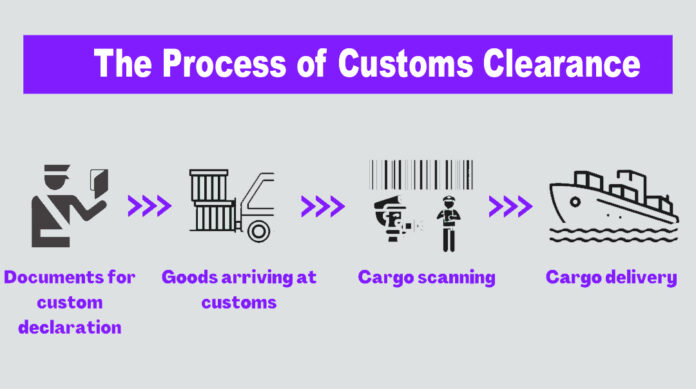Customs clearance is an essential part of the import/export process, ensuring that goods are allowed to enter or exit a country according to its laws, regulations, and tariffs. The process can vary significantly across different countries, but there are common steps involved, which include submitting the correct documents, paying applicable duties and taxes, and ensuring that the Goods conform to the import regulations of the destination country.
Here’s a general outline of how customs clearance works in various countries and the process specifically for Bangladesh:
General Customs Clearance Process (International)
- Preparation of Documents:
- Commercial Invoice: Detailed invoice outlining the goods being imported/exported, their value, and origin.
- Packing List: Detailed list of goods and packaging specifications.
- Bill of Lading (or Air Waybill for air freight): A receipt for the goods and a document of ownership.
- Import/Export Declaration Form: The customs form that provides information about the shipment, including the value, origin, and classification.
- Certificate of Origin: A document stating the country of manufacture, which can affect duty rates.
- Insurance Certificate: Evidence of coverage for the shipment, in the event of damage or loss while in transit.
- Customs Bond: A guarantee that duties and taxes will be paid.
- Import Permit: Some countries require permits for specific goods like chemicals or pharmaceuticals.
- Submit Documents to Customs:
- The shipper or customs broker submits the required documents to the customs authorities. The documents are evaluated to ensure compliance with the country’s laws, regulations, and tariffs.
- Customs Duties & Taxes:
- Customs authorities will assess the goods based on their HS code (Harmonized System code), which determines applicable tariffs and taxes.
- Duties: Taxes imposed on imported goods, often calculated based on the value of the goods or weight.
- VAT/GST: Value Added Tax or Goods and Services Tax may also apply depending on the country.
- Customs Inspection:
- Customs may inspect the goods to verify that the shipment matches the documentation and complies with safety, health, or other regulations.
- Physical inspection can also occur in cases of random checks or if the documentation seems suspicious.
- Payment of Duties & Taxes:
- Once customs determines the duties and taxes, the importer must pay them before the goods are cleared for entry.
- The importer may need to provide additional documentation or pay additional fees if there are discrepancies or special conditions related to the goods.
- Release of Goods:
- After customs clearance, the goods are released, and the importation process is complete. The importer can then arrange for delivery or pick-up.
Customs Clearance Process in Bangladesh
Customs clearance in Bangladesh involves several key steps. Here is how it works:
1. Required Documents:
To clear goods through customs in Bangladesh, the following documents are typically required:
- Bill of Lading (or Air Waybill for air shipments/transports).
- Commercial Invoice.
- Packing List.
- Certificate of Origin (if applicable).
- Import Declaration Form (IDF).
- Customs Duty Payment Receipt.
- Import Permit (for regulated goods like chemicals or pharmaceuticals).
- Insurance Certificate.
- VAT Registration Certificate (for VAT purposes, especially if you’re importing for business purposes).
2. Pre-Arrival Clearance:
- Pre-arrival Filing: In Bangladesh, it is possible to submit certain documents (like the Import Declaration Form or IDF) before the actual arrival of the goods. This helps speed up the process and ensures that everything is in order before the goods reach the port.
- Customs Automated System: The Customs Automated System (ASYCUDA) is used to process import/export declarations, allowing for faster processing and reduced human error.
3. Assessment of Duties and Taxes:
- Bangladesh uses the HS Code (Harmonized System) to determine the applicable duties and taxes on goods being imported.
- Customs Duties: These are assessed based on the value of the goods, as well as their classification under the HS Code.
- Value Added Tax (VAT): In Bangladesh, VAT is typically levied at 15% on most goods, and this must be paid at the time of customs clearance.
- Additional Taxes: There may also be specific excise duties depending on the product (e.g., alcohol, tobacco).
- Customs Duty Rates: These rates vary based on the product’s classification. Bangladesh uses a combination of ad valorem duties (based on the value of goods) and specific duties (based on quantity or weight).
4. Inspection by Customs:
- After the documentation is submitted and duties are assessed, customs authorities may inspect the goods physically or use risk management systems to determine if further inspection is required.
- Random checks are common, especially for high-risk goods or shipments that lack sufficient documentation.
- Scanning: Some goods may be scanned using X-ray machines to check for prohibited items.
5. Payment of Duties and Taxes:
- Once customs has assessed the duties and taxes, these must be paid before the goods can be released. Payment can be made at the Customs House or through authorized banks.
- Bank Guarantees: In some cases, importers may be required to provide a bank guarantee if there are outstanding issues or disputes related to the shipment.
6. Release of Goods:
- After payment, customs will issue a customs release order, and the goods are cleared for delivery.
- The importer can now take possession of the goods or arrange for delivery through a local clearing and forwarding agent.
7. Regulated and Restricted Goods:
- Bangladesh has restrictions on importing certain goods, such as contraband items, counterfeit goods, and products that do not comply with local safety standards.
- Certain items require special permits, including medicines, cosmetics, and chemical substances. Importers must ensure they have the required certifications and approvals for these regulated goods.
8. Post-Clearance Audits:
- Bangladesh’s Customs Department can perform post-clearance audits to ensure that importers comply with all regulations. This is a measure to prevent fraud or under-declaration of values.
Challenges in Bangladesh’s Customs Clearance Process
- Bureaucracy and Delays: Like many countries, Bangladesh may experience delays in customs clearance due to bureaucratic inefficiencies or slow processing times.
- Corruption: Some businesses may face issues with unofficial payments or delays due to corruption, although the government has been working on reforms.
- Lack of Infrastructure: Poor port infrastructure or congestion at major ports like Chittagong Port can lead to delays in clearance.
How to Ensure Smooth Customs Clearance in Bangladesh
- Ensure proper documentation: Ensure that all required documents are complete and accurate. Errors can lead to delays and fines.
- Work with a Customs Broker: If you’re not familiar with the customs process, working with an experienced customs broker or freight forwarder can help ensure smoother clearance.
- Stay updated: Keep track of any changes in customs laws, duties, and taxes in Bangladesh to avoid unexpected costs or delays.
- Be aware of the tariffs: Familiarize yourself with the HS Codes and applicable customs duties for the products you are importing or exporting to prevent overpayment or underpayment of duties.
Conclusion
While customs clearance processes follow a general structure across most countries, specific regulations, documentation requirements, and taxes vary. In Bangladesh, the process includes key documents such as the Import Declaration Form and HS code classification, and involves customs duties and VAT. Staying informed about local regulations and working with experts like customs brokers can help streamline the process and avoid delays.




